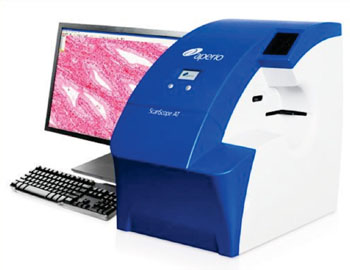Breast Cancer Test Links Immune Hotspots to Better Survival
By LabMedica International staff writers
Posted on 16 Mar 2015
A new test has been developed that can predict the survival chances of women with breast cancer by analyzing images of hotspots where there has been an intense immune reaction to a tumor. Posted on 16 Mar 2015
The test that combines automated histological image processing with methods of spatial statistics could assess whether a woman's immune system is holding a cancer at bay and pick out those who will need intensive treatment to combat their more aggressive disease.

Image: The ScanScope digital slide scanner (Photo courtesy of Aperio Technologies).
Scientists at The Institute of Cancer Research (London, UK) and their colleagues analyzed tumor samples from 245 women with a type of breast cancer called estrogen receptor negative (ER negative), which is particularly hard to treat. The team split women with breast cancer into two groups based on the numbers of immune hotspots spots within their tumors.
The tumor sections were scanned using ScanScope TX Scanner (Aperio Technologies; Vista, CA, USA) with × 20 magnification and digitized for image analysis. Stained frozen tumor section images for 245 ER-negative breast cancer patients were analyzed using their automated cell classification pipeline CRImage. The cell classification and location data were used as input for Getis–Ord hotspot analysis to enable the automated detection of statistically significant spatial clusters.
The scientists found that images of hotspots where immune cells were spatially clustered together around breast cancer cells provided a better measure of immune response than simply the numbers of immune cells within a tumor. Women whose cancers had a high number of spots lived an average of 91 months before their cancer spread, compared with just 64 months for those with a low number of spots. The test is the first objective method of measuring the strength of a patient's immune response to their tumors. Its automated analysis could complement existing methods where pathologists examine tumor samples under the microscope to gain a sense of whether there is a strong immune response.
Yinyin Yuan, PhD, the team leader and senior author, said, “We have shown that to measure the strength of an immune response to a cancer, we need to assess not just how many immune cells there are, but whether these are clustered together into cancer-busting hotspots. By analyzing the complex ways in which the immune system interacts with cancer cells, we can split women with breast cancer into two groups, who might need different types of treatment.” The study was published on February 27, 2015, in the journal Modern Pathology.
Related Links:
The Institute of Cancer Research
Aperio Technologies













